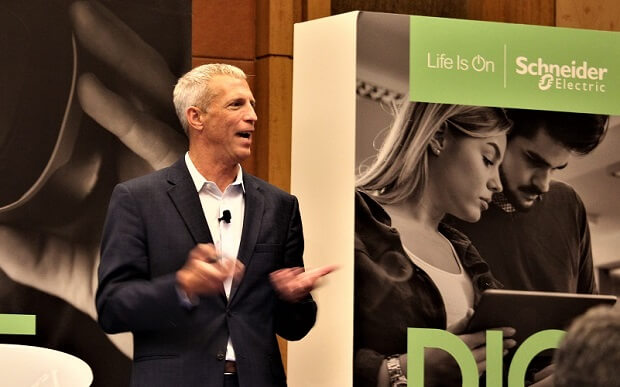French tech giant pitches ‘computing on the edge’
By Joel Pinaroc on September 24, 2019
Information technology (IT) giant Schneider Electric is pitching “edge computing” as an emerging computing platform that is expected to widely impact global businesses.
Schneider Electric senior vice president Kevin Brown
In an event held in Singapore, the France-based company presented its own solutions centered around so-called edge computing.
But what is edge computing? Simply put, edge computing brings the computing power of a data center closer to a customer. Further, “edge computing is also the practice of processing data near the edge of your network, where the data is being generated, instead of in a centralized data processing warehouse.”
Kevin Brown, senior vice president of Schneider Electric, noted that there is “no shortness of hype about edge. But nobody knows what it is and it is just now that the industry is starting to understand.”
Brown said the definition of edge computing may “vary depending on which company is talking” and there seems to be some struggle on what is the right definition of edge is.
The executive said that for Schneider Electric, edge computing is “an architecture” and that company describes this architecture in “edge, edgier, edgiest” terms.
Brown said the architecture starts at the “local edge”.
“When we talk of edge, a basic idea is a laptop connecting to something. And that laptop is the start of the local edge. Edge is driving the need for more computing storage, computing power, customer experience,” Brown said.
He added that edge computing is becoming more relevant because “people’s expectations of performance are much higher than it used to be.”
Schneider Electric’s own offering on edge computing includes local edge, regional edge, even a micro data center solution that is physically close to a user or customer.
Chris Raphael, editor of RT Insights in an online forum said “edge computing refers to data processing power at the edge of a network instead of holding that processing power in a cloud or a central data warehouse.”
“For example, in industrial Internet of things (IoT) applications such as power production, smart traffic lights, or manufacturing, the edge devices capture streaming data that can be used to prevent a part from failing, reroute traffic, optimize production, and prevent product defects,” said Raphael in the online forum.
Raphael’s other examples of edge computing includes “an ATM (the bank wants to stop fraudulent financial transactions); a retail store that is using a beacon to push in-store incentives to a mobile app; a smartphone; a gateway device that collects data from other endpoints before sending it to the cloud, etc. When data analysis is done at the edge of a network, that’s known as “edge analytics.”
Source: NEWSBYTES.PH






